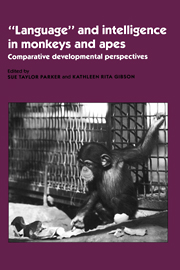Book contents
- Frontmatter
- Contents
- List of contributors
- Foreword
- Preface
- Acknowledgments
- Part I Theoretical frameworks for comparative developmental studies
- Part II Comparative developmental perspectives on cebus intelligence
- Part III Questions regarding imitation, “language,” and cultural transmission in apes and monkeys
- Part IV Developmental perspectives on social intelligence and communication in great apes
- Part V Development of numerical and classificatory abilities in chimpanzees and other vertebrates
- 16 The development of numerical skills in the chimpanzee (Pan troglodytes)
- 17 Spontaneous sorting in human and chimpanzee
- 18 Conceptual abilities of some nonprimate species, with an emphasis on an African Grey parrot
- Part VI Comparative developmental perspectives on ape “language”
- Index
16 - The development of numerical skills in the chimpanzee (Pan troglodytes)
Published online by Cambridge University Press: 11 May 2010
- Frontmatter
- Contents
- List of contributors
- Foreword
- Preface
- Acknowledgments
- Part I Theoretical frameworks for comparative developmental studies
- Part II Comparative developmental perspectives on cebus intelligence
- Part III Questions regarding imitation, “language,” and cultural transmission in apes and monkeys
- Part IV Developmental perspectives on social intelligence and communication in great apes
- Part V Development of numerical and classificatory abilities in chimpanzees and other vertebrates
- 16 The development of numerical skills in the chimpanzee (Pan troglodytes)
- 17 Spontaneous sorting in human and chimpanzee
- 18 Conceptual abilities of some nonprimate species, with an emphasis on an African Grey parrot
- Part VI Comparative developmental perspectives on ape “language”
- Index
Summary
Estimation of quantity and/or related phenomena (e.g., estimation of time) have been demonstrated in a variety of species. Numerous hypotheses have been proposed to account for a range of behaviors observed in rats, raccoons, various species of birds, rhesus monkeys, and chimpanzees relative to the emergence of counting skills in children. An understanding of the cognitive processes that underlie numerical skills in nonhuman animals could provide information critical to clarifying the evolution of cognitive capabilities.
Capaldi and Miller (1988) suggested that despite opportunities to employ other strategies for task solution, animals readily use counting cues to solve a variety of instrumental problems. Capaldi and his colleagues further proposed that counting mechanisms may explain a wide range of learning situations in rats and other mammals. In contrast, Davis and Memmott (1982) proposed that animals engage in counting as a last-resort strategy and questioned the evolutionary significance of such capacities, given that these behaviors often require intensive training in a highly structured laboratory situation (e.g., Davis, 1984; Ferster, 1964).
The degree to which counting behaviors in nonhuman species fit the criteria for true counting, as defined for children (Gelman & Gallistel, 1978), is a point of controversy (Davis & Perusse, 1988). Interestingly, discussion of related issues pervades the human developmental literature (e.g., Gelman & Gallistel, 1978; Piaget, 1952), including the age at which children are capable of demonstrating counting, as opposed to subitizing (Beckmann, 1924; Mandler & Shebo, 1981), that is, the proposed ability to estimate small numbers of items in an array through a direct perceptual apprehension mechanism (von Glasersfeld, 1982).
Information
- Type
- Chapter
- Information
- 'Language' and Intelligence in Monkeys and ApesComparative Developmental Perspectives, pp. 435 - 450Publisher: Cambridge University PressPrint publication year: 1990
Accessibility standard: Unknown
Why this information is here
This section outlines the accessibility features of this content - including support for screen readers, full keyboard navigation and high-contrast display options. This may not be relevant for you.Accessibility Information
- 7
- Cited by
